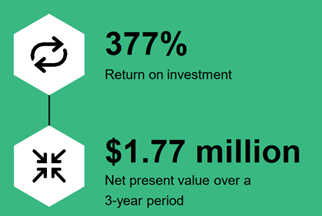September 25, 2023 - by Synoptek
The global enterprise resource planning (ERP) software market is forecasted to grow to around $101 billion by 2026. As competition increases, the final decision on which ERP platform is best for you is not easy. Two solutions that you’re most likely to consider are Dynamics 365 and SAP. Even though SAP S/4 HANA has been a popular choice for organizations, Microsoft Dynamics 365 Finance offers some superior features.
In this blog, we will conduct a head-to-head comparison of the two ERP giants. The comparison should help you make the right ERP choice for your business.
Dynamics 365 Finance Overview
Dynamics 365 Finance is a strong contender in the ERP market, with comparatively lower costs and easier implementation. Built on the Microsoft infrastructure, it utilizes cutting-edge AI, BI, and automation capabilities to strengthen business operations. It effortlessly syncs and integrates with a host of day-to-day business applications, transforming productivity through deep insights.
Total Economic Impact of Microsoft Dynamics 365 Finance
Source: Forrester
What works for Microsoft is the familiar interface, the simple look and feel, access to intelligent Finance Insights, and the numerous integration options, making it a popular ERP choice across diverse industry verticals.
SAP S/4 HANA Overview
In the tech world, SAP S/4 HANA is synonymous with ERP. It is considered the undisputed market leader with a strong share of the ERP market. With localization capabilities for over 120 countries, it has a large reach – not just geographically but also across various industries. Although SAP is more expensive than the other ERP leaders and has a rather long learning curve, it is still favored by many large organizations around the world.
Source: SAP
What works for SAP is its deep industry-specific capabilities and expertise gained over the years from thousands of successful implementations.
Dynamics 365 vs. SAP – A Comparison
Choosing between Dynamics 365 Finance and SAP S/4HANA depends on your organization’s specific needs, existing technology stack, industry focus, and long-term goals. As you engage in a thorough evaluation, possibly involving IT experts or consultants who are well-versed in both systems, here are some comparison points to keep in mind:
S. No. |
Capability |
Dynamics 365 for Finance |
SAP S/4 HANA |
|---|---|---|---|
| 1 | Customizations | Customizations to suit industry and business needs are effortless; businesses can either customize using in-house talent or choose from an extensive network of experienced partners. | To customize the out-of-the-box solution, organizations need to have deep knowledge of SAP’s traditional architecture and data models. |
| 2 | Integration Options | Dynamics 365 offers seamless integration with myriad Microsoft applications, including Outlook, Office 365, and Power BI. | Since SAP is built on niche technology, integration with modern apps requires the adoption of a unique integration path and special integrators. |
| 3 | Ease of Use | Microsoft Dynamics 365’s familiar interface with the option to personalize views, fields, and forms without extensive coding enables organizations to implement changes faster and get businesses up to speed. | Most SAP ERP modules employ a complex GUI and have a steep learning curve for first-time users. |
| 4 | TCO | Microsoft Dynamics 365’s flexible pricing options and reasonable implementation and support costs help keep TCO to a minimum. | Although SAP offers cutting-edge features, the TCO is among the highest; very often, users find themselves paying for modules they’ve never used. |
| 5 | Deployment Options | A range of on-premises and cloud options, with a greater focus on the cloud. | A range of on-premises and cloud options. |
| 6 | Industry Focus | Dynamics 365 Finance is suitable for small, mid, and large enterprises across various industries and sectors. | SAP S/4 HANA is particularly beneficial for companies in the manufacturing and supply chain industries. |
| 7 | Pros | Easy to use Flexible Easy integration Low cost |
Rich features Industry-specific functionality Reporting and analytics Integrated processes |
| 8 | Cons |
|
|
| 9 | Pricing | $180/user /month | $9.6 /capacity unit/year |
| 10 | Implementation time | Quick to implement | Longer implementation time |
Microsoft Dynamics 365 vs. SAP: Which Is Better?
The battle of the ERPs will never cease to exist. As you look to implement an ERP solution across your organization, picking an ERP that best fits your business size and type requires you to study each product roadmap carefully. You must also deep dive into the functionality and architecture to make the right business decision.
Although SAP might be the preferred choice for large organizations looking for expertise in niche technologies, Dynamics 365 Finance is popular amongst small and medium enterprises.
So, what should you consider while making the right ERP decision? If you are looking for ease of use, quick integrations, and low costs, you should go for Dynamics 365 Finance. If you are looking for powerful industry-specific features, extensive support capabilities, and a robust database, you should opt for SAP S/4 HANA.



